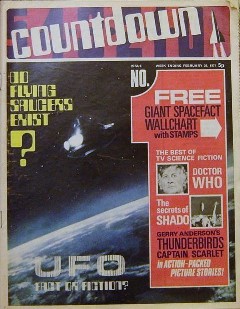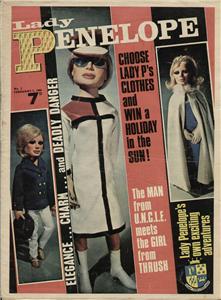Related Research Articles

A British comic is a periodical published in the United Kingdom that contains comic strips. It is generally referred to as a comic or a comic magazine, and historically as a comic paper. As of 2014, the three longest-running comics of all time were all British.
Michael Anglo was a British comic book writer, editor and artist, as well as an author. He was best known for creating the superhero Marvelman, later known as Miracleman.

Frank Bellamy was a British comics artist, best known for his work on the Eagle comic, for which he illustrated Heros the Spartan and Fraser of Africa. He reworked its flagship Dan Dare strip.

Countdown was a British comic published weekly by Polystyle Publications – ultimately, under several different titles – from early 1971 to late summer 1973. The pages in each issue were numbered in reverse order, with page 1 at the end – a gimmick which was derived from the comic's title in order to create a countdown to the number one every week.

Valiant was a weekly British comics periodical published by Fleetway Publications and later IPC Magazines from 4 October 1962 to 16 October 1976. A boys' adventure comic, it debuted numerous memorable characters, including Captain Hurricane, The Steel Claw and Mytek the Mighty. Valiant lasted for 712 issues before being merged with stablemate Battle Picture Weekly.

TV Comic was a British weekly comic book published from 9 November 1951 until 29 June 1984. Featuring stories based on television series running at the time of publication, it was the first British comic to be based around TV programmes and spawned a host of imitators.

TV Century 21, later renamed TV21, TV21 and Tornado, TV21 and Joe 90, and TV21 again, was a weekly British children's comic published by City Magazines during the latter half of the 1960s. Originally produced in partnership with Gerry and Sylvia Anderson's Century 21 Productions, it promoted the company's many science-fiction television series. The comic was published in the style of a newspaper of the future, with the front page usually dedicated to fictional news stories set in the worlds of Fireball XL5, Stingray, Thunderbirds, Captain Scarlet and the Mysterons and other stories. The front covers were also in colour, with photographs from one or more of the Anderson series or occasionally of the stars of the back-page feature.

Lady Penelope was a British weekly comic book magazine for girls which ran from 1966 to 1969. Produced by Century 21 Publications and published by City Magazines, it was a sister publication to TV Century 21. Lady Penelope was edited by Gillian Allan, wife of comic strip writer Angus Allan.
Playhour was a British children's comics magazine published by Amalgamated Press/Fleetway/IPC between 16 October 1954 and 15 August 1987, a run of approximately 1,700 weekly issues. Playhour contained a mixture of original tales for young children and adaptations of well-known fairy tales.

Smash! was a weekly British comic book, published initially by Odhams Press and subsequently by IPC Magazines, from 5 February 1966 to 3 April 1971. After 257 issues it merged into Valiant.

Power Comics was an imprint of the British comics publisher Odhams Press that was particularly notable for its use of material reprinted from American Marvel Comics. Appearing chiefly during the years 1967 and 1968, the Power Comics line consisted of five weekly titles: Wham!, Smash!, Pow!, Fantastic and Terrific. The first three of these titles were essentially traditional The Beano-style British comics papers, supplemented by a small amount of Marvel and DC Comics material, while Fantastic and Terrific were more magazine-like in style and were dominated by their Marvel superhero content.

The Century 21 Organisation was a group of companies founded by Gerry Anderson in the early 1960s to expand on his television production company, AP Films (APF; later Century 21 Productions). In addition to APF, the group included:
Ronald Turner was a British illustrator and comic book artist.

Odhams Press was a British publishing company, operating from 1920 to 1968. Originally a magazine publisher, Odhams later expanded into book publishing and then children's comics. The company was acquired by Fleetway Publications in 1961 and then IPC Magazines in 1963. In its final incarnation, Odhams was known for its Power Comics line of titles, notable for publishing reprints of American Marvel Comics superheroes.
Tom Kerr was a British comic strip artist whose work has appeared in comics such as Look-in, the Eagle, Valiant, and TV21. He has also drawn for many annuals of the 1960s and 1970s, including the Monkees annuals, Look-in annuals, etc. He is not to be conflated with the Australian cartoonist of the same name, who was responsible for such creations as Daddles, an animated duck that would walk along the TV screen when a cricketer scored a duck.

Mike Noble was a British comic artist and illustrator, best known for drawing strips like Fireball XL5 for TV Century 21.
Denis Gifford was a prolific comic artist and writer, most active in the 1940s, 50s and 60s. Gifford's work was largely of humour strips in British comics, often for L. Miller & Son. He was an influential comics historian, particularly of British comics from the 19th century to the 1940s.

Princess Tina was a British weekly girls' comic anthology published by Fleetway Publications and IPC Magazines from 23 September 1967 to 12 January 1974. The comic was created by combining two underperforming Fleetway titles — Princess and Tina — into a third, new comic. Notable strips included the long-running family drama "The Happy Days" and "Patty's World". The latter would outlive Princess Tina, continuing after the comic was merged into Pink.
World Distributors was a British publisher and distributor of magazines and comic books. The company was known for repackaging American comics and producing comic book annuals based on licensed properties. For a period, the company was the lone distributor of American comics in the UK. Pembertons was owned and operated by the brothers Alfred, John, and Sydney Pemberton, originally based in Manchester.
British girls' comics flourished in the United Kingdom from the 1950s through the 1970s, before beginning to decline in popularity in the 1980s and 1990s. Publishers known for their girls' comics included DC Thomson and Fleetway/IPC. Most titles appeared weekly, with the content primarily in picture-story format. The majority of the stories were serialized, with two or three pages per issue, over eight to twelve issues. They were marketed toward young teen girls.
References
Notes
- 1 2 "Parade" at Magforum. Archived at the Wayback Machine. Retrieved Apr. 20, 2021.
- 1 2 3 Freeman, John. "Landmark British Comics: Looking Back on TV21 Issue 200," DownTheTubes.net (Oct. 29, 2015).
- 1 2 3 4 George Beal, Obituary: Leonard Matthews, The Independent , 5 December 1997
- 1 2 Stringer, Lew. "Flashback 1969: TV21 & Joe 90 No.1," Blimey! The Blog of British Comics! (November 25, 2007).
- ↑ Stringer, Lew. "This week in 1970: TV2," Blimey! The Blog of British Comics! (December 01, 2012).
- ↑ Stringer, Lew. "The Road to Marvel UK - Part 3," Blimey! The Blog of British Comics! (February 01, 2008).
- ↑ Murray, Chris. "Mergers and Marvels (1962–1980)," The British Superhero (Univ. Press of Mississippi, 2017), p. 173.
- 1 2 "Carnival [closed]," Magforum. Archived at the Wayback Machine. Retrieved Apr. 20, 2021.
- ↑ "Escort [closed]," Magforum. Archived at the Wayback Machine. Retrieved Apr. 20, 2021.
- ↑ "Men Only," Magforum. Archived at the Wayback Machine. Retrieved Apr. 20, 2021.
- ↑ Holland, Steve (2008). "Introduction". The Best of Boyfriend. Prion. ISBN 9781853756658.
- ↑ Alderson, Connie (1968). Magazines Teenagers Read. Pergamon Press.
- ↑ Gifford, Denis (1975). The British Comic Catalogue 1874-1974. Greenwood Press. ISBN 9780837186498.